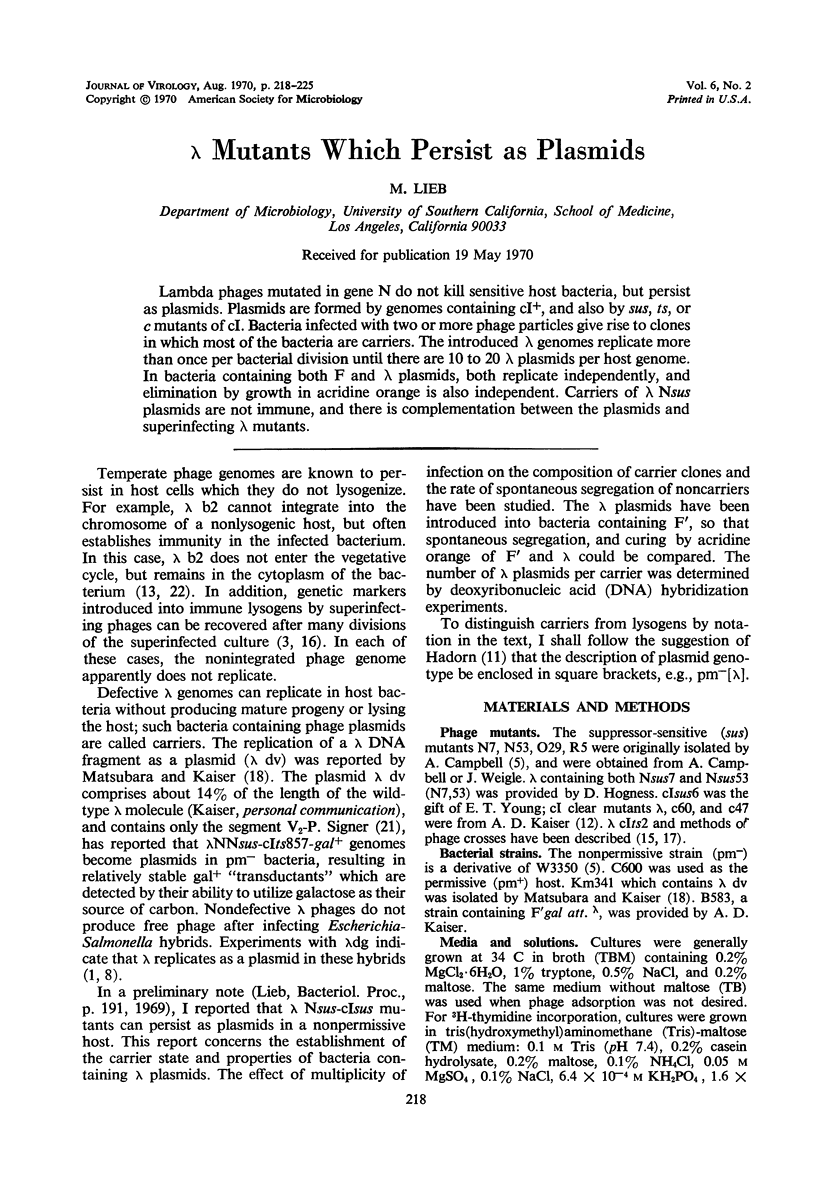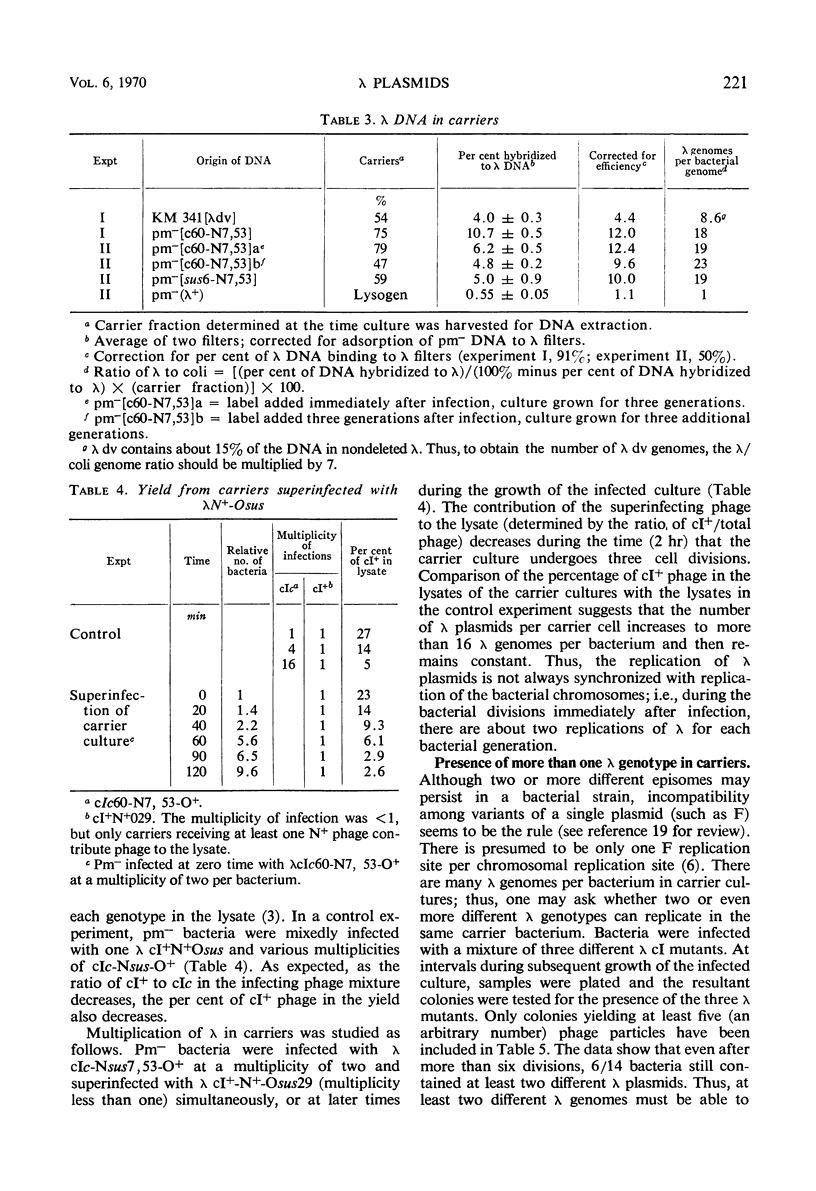Abstract
Lambda phages mutated in gene N do not kill sensitive host bacteria, but persist as plasmids. Plasmids are formed by genomes containing cI+, and also by sus, ts, or c mutants of cI. Bacteria infected with two or more phage particles give rise to clones in which most of the bacteria are carriers. The introduced λ genomes replicate more than once per bacterial division until there are 10 to 20 λ plasmids per host genome. In bacteria containing both F and λ plasmids, both replicate independently, and elimination by growth in acridine orange is also independent. Carriers of λ Nsus plasmids are not immune, and there is complementation between the plasmids and superinfecting λ mutants.
Full text
PDF







Selected References
These references are in PubMed. This may not be the complete list of references from this article.
- BERTANI G. Lysogenic versus lytic cycle of phage multiplication. Cold Spring Harb Symp Quant Biol. 1953;18:65–70. doi: 10.1101/sqb.1953.018.01.014. [DOI] [PubMed] [Google Scholar]
- BERTANI G. Studies on lysogenesis. III. Superinfection of lysogenic Shigella dysenteriae with temperate mutants of the carried phage. J Bacteriol. 1954 Jun;67(6):696–707. doi: 10.1128/jb.67.6.696-707.1954. [DOI] [PMC free article] [PubMed] [Google Scholar]
- BROOKS K. STUDIES IN THE PHYSIOLOGICAL GENETICS OF SOME SUPPRESSOR-SENSITIVE MUTANTS OF BACTERIOPHAGE LAMBDA. Virology. 1965 Jul;26:489–499. doi: 10.1016/0042-6822(65)90011-5. [DOI] [PubMed] [Google Scholar]
- Baron L. S., Penido E., Ryman I. R., Falkow S. Behavior of coliphage lambda in hybrids between Escherichia coli and Salmonella. J Bacteriol. 1970 Apr;102(1):221–233. doi: 10.1128/jb.102.1.221-233.1970. [DOI] [PMC free article] [PubMed] [Google Scholar]
- CAMPBELL A. Sensitive mutants of bacteriophage lambda. Virology. 1961 May;14:22–32. doi: 10.1016/0042-6822(61)90128-3. [DOI] [PubMed] [Google Scholar]
- Cuzin F., Jacob F. Existence chez Escherichia coli d'une unité génétique de ségrétion formée de différents réplicons. C R Acad Sci Hebd Seances Acad Sci D. 1965 May 17;260(20):5411–5414. [PubMed] [Google Scholar]
- Denhardt D. T. A membrane-filter technique for the detection of complementary DNA. Biochem Biophys Res Commun. 1966 Jun 13;23(5):641–646. doi: 10.1016/0006-291x(66)90447-5. [DOI] [PubMed] [Google Scholar]
- FISCHER-FANTUZZI L., CALEF E. A TYPE OF LAMBDA PROPHAGE UNABLE TO CONFER IMMUNITY. Virology. 1964 Jun;23:209–216. doi: 10.1016/0042-6822(64)90284-3. [DOI] [PubMed] [Google Scholar]
- Falkow S., Baron L. S. Plasmid formation after lambda bacteriophage infection of Escherichia coli-Salmonella typhosa hybrids. J Bacteriol. 1970 Apr;102(1):288–290. doi: 10.1128/jb.102.1.288-290.1970. [DOI] [PMC free article] [PubMed] [Google Scholar]
- GROMAN N. B., SUZUKI G. Temperature and lambda phage reproduction. J Bacteriol. 1962 Sep;84:431–437. doi: 10.1128/jb.84.3.431-437.1962. [DOI] [PMC free article] [PubMed] [Google Scholar]
- KAISER A. D. Mutations in a temperate bacteriophage affecting its ability to lysogenize Escherichia coli. Virology. 1957 Feb;3(1):42–61. doi: 10.1016/0042-6822(57)90022-3. [DOI] [PubMed] [Google Scholar]
- LIEB M. Studies on lysogenization in Escherichia coli. Cold Spring Harb Symp Quant Biol. 1953;18:71–73. doi: 10.1101/sqb.1953.018.01.015. [DOI] [PubMed] [Google Scholar]
- LIEB M. The establishment of lysogenicity in Escherichia coli. J Bacteriol. 1953 Jun;65(6):642–651. doi: 10.1128/jb.65.6.642-651.1953. [DOI] [PMC free article] [PubMed] [Google Scholar]
- Lieb M. Studies of heat-inducible lambda bacteriophage. I. Order of genetic sites and properties of mutant prophages. J Mol Biol. 1966 Mar;16(1):149–163. doi: 10.1016/s0022-2836(66)80269-3. [DOI] [PubMed] [Google Scholar]
- Lieb M. Studies of heat-inducible lambda mutants. II. Production of C-1 product by superinfecting lambda+ in heat-inducible lysogens. Virology. 1966 Jul;29(3):367–376. doi: 10.1016/0042-6822(66)90212-1. [DOI] [PubMed] [Google Scholar]
- Lieb M. Studies of heat-inducible lambda-phage. 3. Mutations in cistron N affecting heat induction. Genetics. 1966 Sep;54(3):835–844. doi: 10.1093/genetics/54.3.835. [DOI] [PMC free article] [PubMed] [Google Scholar]
- Matsubara K., Kaiser A. D. Lambda dv: an autonomously replicating DNA fragment. Cold Spring Harb Symp Quant Biol. 1968;33:769–775. doi: 10.1101/sqb.1968.033.01.088. [DOI] [PubMed] [Google Scholar]
- Novick R. P. Extrachromosomal inheritance in bacteria. Bacteriol Rev. 1969 Jun;33(2):210–263. doi: 10.1128/br.33.2.210-263.1969. [DOI] [PMC free article] [PubMed] [Google Scholar]
- Ogawa T., Tomizawa J. Replication of bacteriophage DNA. I. Replication of DNA of lambda phage defective in early functions. J Mol Biol. 1968 Dec 14;38(2):217–225. doi: 10.1016/0022-2836(68)90407-5. [DOI] [PubMed] [Google Scholar]
- Signer E. R. Plasmid formation: a new mode of lysogeny by phase lambda. Nature. 1969 Jul 12;223(5202):158–160. doi: 10.1038/223158a0. [DOI] [PubMed] [Google Scholar]
- ZICHICHI M. L., KELLENBERGER G. Two distinct functions in the lysogenization process: the repression of phage multiplication and incorporation of the prophage in the bacterial genome. Virology. 1963 Apr;19:450–460. doi: 10.1016/0042-6822(63)90038-2. [DOI] [PubMed] [Google Scholar]


